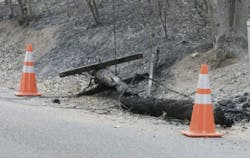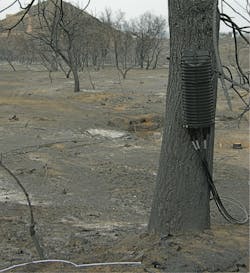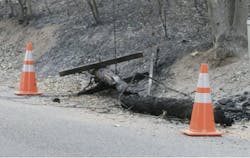The Washington Post newspaper for January 4, 2024, had an interesting headline: “Virtually the entire Lower 48 is about to experience extreme weather.” The subhead was “U.S. weather is about to go crazy. From tornadoes to blizzards to massive waves, here are seven things to watch.”1 Perhaps I should have written “scary headline” instead of “interesting headline.” Maybe we’ve gotten used to these kinds of headlines, but I bet everyone reading this has a story to tell about the weather in their region in the last year or two.
Last Summer I received a call from FEMA, the U.S. Federal Emergency Management Agency, looking for information on restoration of fiber optic networks. FOA has quite a lot of information on the website about restoration, originally created based on the fears about “backhoe fade,” dig-ups of underground cables (almost a daily occurrence), and damage to aerial cables caused by “target practice” (also fairly common).
FEMA, however, was focused on natural disasters like hurricanes and tornadoes, flooding, wildfires, and other disasters that are reported almost daily in the news. Over a long call, I learned their response to disaster recovery prioritizes restoring power and communications, both necessary for recovery efforts to be successful. Other priorities like medical assistance, potable water, food, etc. all need power and communications to coordinate relief efforts. Armies of experienced techs are needed to restore the electrical grid and communications networks; coordinating those efforts are a major part of FEMA’s work.
Compared to natural disasters, backhoe fade and target practice are minor annoyances. They are localized and a couple of experienced techs can make repairs quickly. In a natural disaster, hundreds of utility poles may be down, manholes flooded, and sometimes equipment destroyed, flooded, or burned out. Entire towns or regions can be cut off from communications, exactly what happened when Hurricane Otis hit Acapulco last year.
And weather events are getting worse. East coast cities are facing worse weather events combined with sea level rise. Here in California, we have hotter, dryer weather intensifying the wildfire season in parts of the state and flooding caused by monsoon rains in others. We even have record snowfalls in parts of the Sierras burying houses all winter. Don’t even mention earthquakes! According to a recent report published by Next Century Cities, the number of “billion-dollar disaster events” has quadrupled in the last 40 years.2
Our conversation with FEMA eventually turned to how project design can mitigate disaster effects. One California electrical utility is vowing to move their transmission and distribution lines underground in wildfire-prone areas. The cost is astronomical, but so are the payouts they are making because their aerial cables started past wildfires causing billions of dollars of damage.
Practically every disaster story seems to show pictures of utility poles that have crashed down across roads. Yet many service providers I’ve talked to about fiber broadband projects with the coming Federal BEAD funding are focused on aerial cable plants. The reasoning is almost always the same, aerial costs less than underground. At least until the first time it needs rebuilding.
We know regions that no longer use aerial cable plants, especially in Northern climates where winter icing is common or dry areas where wildfires are expected. Does aerial make sense in an area that expects several hurricanes a year? Or when new technology like microtrenching makes underground construction much easier and less expensive?
It's not just aerial cables that are at risk. We've seen flooding in many areas during this very wet winter/spring and sea rise is threatening many coastal cities. That can cause problems with underground infrastructure if flooding has not been considered in the design, especially for coastal cities where flooding is salt or brackish water.
Winter can bring a special set of problems to underground cables. FOA has been sent photos of splice closures that filled with water and froze, disrupting the network. FOA was even sent a photo of a flooded manhole that froze solid in a very cold winter. The question asked was “how do you thaw up a frozen manhole?”; the answer was “wait for springtime.”
Wireless towers are at risk also. Wind, icing, and the combination of both can bring down towers. During last year’s California wildfires, several towers were in the middle of the fires but fortunately the owner had created sufficient fire breaks around them to protect them.
With all the disruptive weather we have been having, others have contacted FOA to ask for advice on planning and designing networks to survive disasters. It's obviously not a simple subject and there will be a wide variety of conditions to plan for, depending on where you live. Planning really takes two paths, how to mitigate damage to your networks in weather disasters and, secondly, how to react when disaster strikes.
While FEMA is concerned and may influence government rules and regulations, local government agencies have also been more actively planning for disasters. But this is not a problem that service providers can ignore; it is very likely to affect their “bottom line” soon.
References
1. The Washington Post, https://www.washingtonpost.com/weather/2024/01/04/us-extreme-weather-snow-tornadoes-flooding/
2. Next Century Cities, https://nextcenturycities.org/wp-content/uploads/2021/05/Wildfires-Natural-Disasters-Network-Resilience_Johnston.pdf
About the Author
Jim Hayes
Fiber Optic Expert
Jim Hayes is the Fiber Optic Expert columnist for ISE Magazine. He is a lifelong techie who has been involved in the fiber optic industry since the late 1970s. He founded one of the world's first fiber optic test equipment companies, FOTEC, which was acquired by Fluke in 2000, and he was a co-founder of the Fiber Optic Association (FOA), the international professional society of fiber optics, in 1995.
Jim is a writer and trainer and the President of FOA. He is the author of nine books on fiber optics and cabling and writes for several magazines.
Jim and his wife, Karen, who is the GM of the FOA, have traveled the world for the FOA helping set up schools to train the workers who design, build, and operate today's communications networks. The FOA offers nearly 1,000 pages of online technical materials, over 100 videos, and two dozen free self-study courses online.
For more information, email [email protected] or visit www.jimhayes.com.
To learn more about The Fiber Optic Association, visit www.thefoa.org. Follow them on Facebook: FiberOpticAssociation, LinkedIn: company/the-fiber-optic-association-inc-foa, and YouTube: user/thefoainc.




